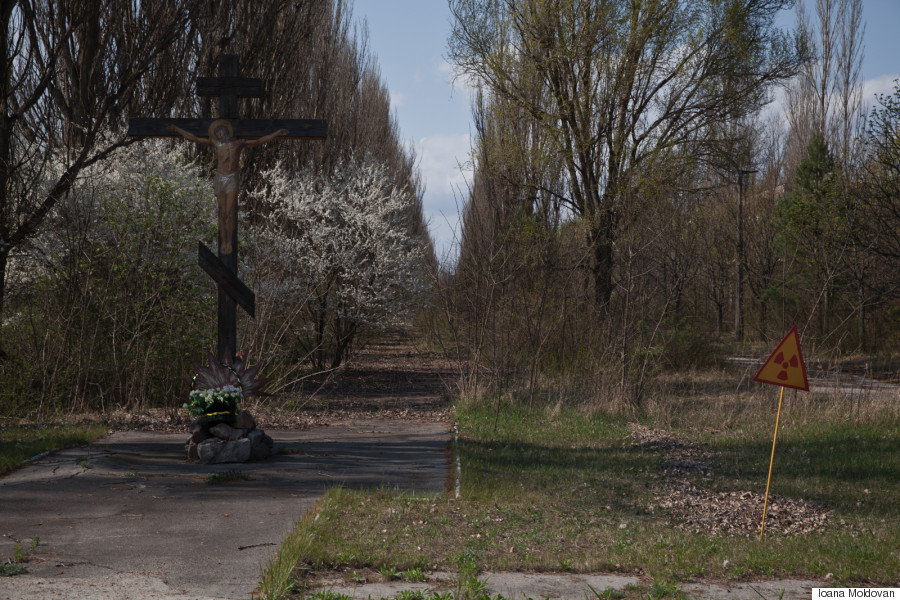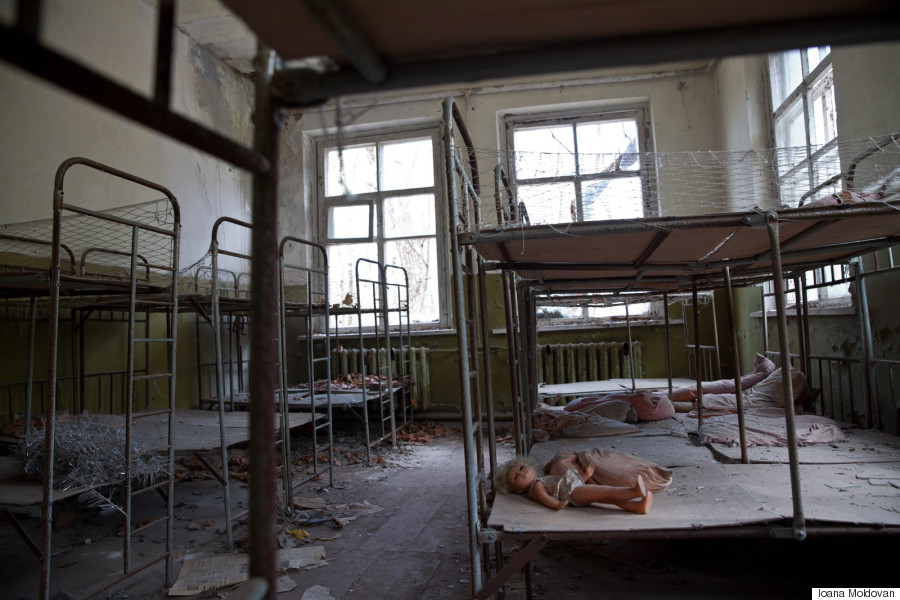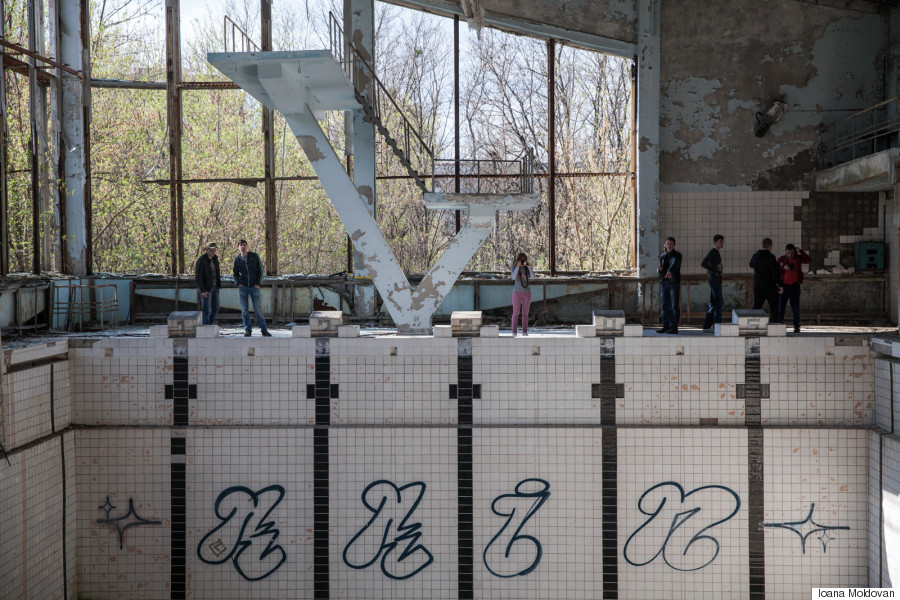CHERNOBYL, Ukraine — It was a fine spring night, people peacefully sleeping as weekday passed into weekend, until Chernobyl’s fourth nuclear reactor blew up.
Oleksandr Galuh recalls that night well.
“My mother woke up as the windows shattered,” Galuh, then a fourth-grader in Pripyat, a town not too far from Chernobyl, remembers. “She thought it was a thunderstorm.”
But no thunder rocked the still of night — an explosion did. It was April 26, 1986 at 1:23 a.m. when reactor no. 4 of the Chernobyl nuclear power plant went up in flames. The worst nuclear accident in history had just taken place.
The fire would burn for 10 days, with tens of thousands of square kilometers covered by the fallout cloud.
“The next morning, my uncle came and told us about the accident and that there had been a big disaster,” says Galuh, now a full-grown man living in Kiev.
Pripyat, the Soviet town built in the 1970s for the plant’s personnel, was closest to the reactor, less than 3 kilometers away. It took 36 hours before people started being evacuated.
“We were told to take some provisions for three days only, because the city would be cleaned and then we could return,” Galuh says. “I remember people coming out with happy faces, with tennis rackets and other things for spending free time. No one expected they would never come back.”

Pripyat, the closest town to Chernobyl nuclear power plant, was evacuated after the nuclear accident in 1986. Over time, nature has taken over the ghost town.
Chernobyl — the tourist attraction
Today, it is mostly silence that surrounds the abandoned buildings that stand as testimony to the hasty departure. There’s not much left after the place was looted in the 1990s: a scattered doll here, a piece of derelict furniture there, a rusty mailbox hanging from a stump. But the chilling ghost town has a new ruler now: nature. It has taken over the city, reclaiming its territory and more: trees grow through the broken windows, moss is pushing out through the cracks of the asphalt, an owl sometimes nests in Galuh’s old apartment.
Yet silence in “the Zone” — as the 30 kilometer exclusion area around the Chernobyl reactor is dubbed — does get interrupted. And it is not just birds chirping in the trees. It’s the beeping sound of tourists’ Geiger counters.
Nikolai Fomin has been a Chernobyl tour guide since 2009 and has over 500 tours under his belt. In his opinion, nature recovers here and even takes over not because of lack of radiation, but because of lack of people. Pripyat looks more like a jungle than a town now.
“People coming back don’t recognize the place,” Fomin says. “They give me their old addresses and ask me to take them there. They all cry.”
The Chernobyl tourist tour is like a walk through Ukraine’s graveyard of bad memories. It takes history disaster lovers through Zalissya, one of the 186 communities that has been evacuated from the Chernobyl area. Here, alone among abandoned, decayed houses, lives old Rozaliya Ivanivna, a “self-settler” getting fed up with tourists. An abandoned kindergarten in Kopachi is the next attraction. The streets around have been paved with multiple layers of asphalt to cover any remaining contamination. But it’s at the base of a tree where Geiger counters, pointed at some patches of dirt, go wild. Fomin’s shows 10 microsieverts per hour, up to 100 times more than the normal limit that can be found anywhere in the world. When one gets an abdominal and pelvic CT scan, the radiation amount counts 10 millisieverts per hour (10,000 microsieverts/h) and is comparable to three years time of exposure to natural background radiation.

Abandoned kindergarten in Kopachi in the 30 kilometer exclusion area around the Chernobyl reactor known as “the Zone.”
Fomin is concerned with the increasing numbers of tourists roaming the area.
“I see how things change from tour to tour,” he says. “Furniture pieces are not in the same place, books tend to be open at Lenin’s photo, everything seems more and more staged.”
The highlight of the tour is getting near Chernobyl plant’s reactor no. 4, some 200 meters from its remains. That’s as close as tourists can get. From the other side of the tall fence surrounding the complex, they can see the new “sarcophagus” shining in the sun. The old “sarcophagus,” or containment, was assembled back in 1986 and was intended to be temporary. The New Safe Containment is meant to cover reactor no. 4 and offer protection from still dangerous radiation for a century to come.
Aleksandr Kupny, one of the most outspoken critics of the slow-moving sarcophagus project, is not that confident that it will last this long.
“The sarcophagus is not hermetic, was not designed to be,” he said. “If, God forbid, something collapses in there, it will equal a 3 to 4 level tornado of dust. … There are already 35 tons of dust accumulated there and it is radioactive.”
Kupny comes from a “House of Chernobyl”: his father was a director of the complex after the accident and his son started work there a few years ago. The grey haired man worked as a liquidator himself back in 1988. He remembers entering the Zone for the first time after the accident that year: the once lively towns he knew well were all empty and the only people around were dressed alike — the same dark-colored pullovers, the same boring grey hats. Most probably, back then he would not have imagined the area would one day be crawling with tourists.

Group of tourists in the abandoned building of the former swimming pool of Pripyat.
The two realities
Nikolai Fomin, the Chernobyl tour guide, says people in Ukraine don’t like to talk about Chernobyl because it is seen as a bad part of their history, a terrifying place. He’s closing on 40, and he doesn’t recollect any history lessons in school about it or any discussions at home either. And nuclear energy is not such a big topic among Ukrainian people.
“People don’t have time to think about it,” he says. “They are more worried about how to survive in these conditions: the new government, the war in the east. We need to think about food, currency rate, doubling or tripling prices, we don’t have time to worry about the consequences of nuclear energy.” But as he himself says, “we should think about Chernobyl, about Fukushima. We should remember that. And we should remember that nuclear power is not without the consequences.”
Just like usual, on the Friday evening before the Chernobyl disaster, an older school colleague of Galuh went fishing at the reservoir, the electrical unit’s cooling tank.
“He told us how he saw everything,” Galuh recalls. “It happened right next to him, fire, flames. The next year he died.”
Fast forward some 30 years further in time to Kiev where a young girl takes the pills a nurse hands her after lunch.
“There are two realities,” says Bozhenko Vadim Borisovich, medical director at the hospital for radiation diseases in Kiev. “The official one of the State Nuclear Regulatory Inspectorate of Ukraine saying there is no more danger related to the Chernobyl accident, and the one I get to witness every day in this hospital.”
The medical center was opened on Aug. 1, 1986, accepting all “Chernobyl status” persons. Ever since, it has treated over 60,000 children and 600,000 adults, according to Borisovich. About a year ago when I was there, 100 children were hospitalized due to reactions from radiation.

Young Ukrainian girl sleeping in one of the rooms of the hospital for radiation diseases in Kiev.
There aren’t completely accurate figures about the number of people affected by Chernobyl. The data that Borisovich has shows that, on Jan. 15, 2015, the number affected by the power plant disaster was 2,011,799. Out of those, 453,391 were children.
“There are lots of children living in polluted areas that ingest radiation through food and water,” Borisovich says. “Children and grandchildren of Chernobyl victims present inborn malformations. Every child living there is sick. They all suffer from four to five diseases because of low immunity.”
The present day danger: NPPs weren’t designed for war
Some 500 kilometers southwest of Kiev, six huge red-and-white-striped chimneys furrow the horizon. Lively Ukrainian music comes out of a Lada — an old Russian car model — as fishing poles line up on the water’s edge, fish bait waiting at thread’s end. The extreme close proximity of Ukraine’s largest nuclear plant, Zaporizhia, does not seem to bother the fishermen.
“How shall I put it? People are more concerned with daily struggles, food and generally think only about today,” says Vasili Bilitsky, a local environmental activist. “They are fishing in order to eat, it is not relaxation. That’s why they don’t think about eating something non-eatable.”
Water splashes through the metallic mesh as caught fish struggle. Poles move back and forth tirelessly, in search for a better spot.
“[The power plant] is here and doesn’t bother me,” says one of the local fishermen, a dark-haired robust man in his 40s. “Some time ago, electricity was cheaper for us living in the vicinity, but now the privileges have been cancelled, same price goes for all. Generally though it’s OK. Look for yourselves, you can fish,” he adds. “The water is warmer so fishing goes all year-round.”
When people need to worry about everyday life, about making a living in an eroded economy, thinking about the danger of nuclear reactors does not even come second.
“There are no safe nuclear reactors. There is no economic stability that allows safe operation,” says Vladimir Ivanovich, former Chernobyl liquidator and former lawmaker. “Recession means lower operational quality so reactors become dangerous. Most terribly, unstable situations often occur. Right now we have Russia’s aggression and for the first time we have a continuing armed conflict next to nuclear reactors.”
Zaporizhia nuclear plant sits only 200 kilometers away from the front line in the east.
“Putin must connect Crimea by land and this goes through Zaporizhia region, through Berdiansk, Melitopol and on to Crimea,” says Bilitsky, the environmental activist. “Energodar [the small town in which the plant is actually located] is only a stone’s throw away from Melitopol [another town in Zaporizhia region]… Shoot a powerful cannon and you’re there.”
But the war in Ukraine has seen much more than a cannon shot. It has seen heavy artillery fire and even Grad missiles. People are scared that Russian troops are close and have weaponry that can hit the power plant.
“This should never happen here,” says Sergei Shygyn, chief specialist for nuclear reactors at the Zaporizhia nuclear power plant. “Both Ukraine and the international community should prevent military actions here.” He continues: “The media asked me if Zaporizhia NPP can withstand military action. It can’t. NPP’s were not designed for war.”
Having military action just around the corner, one of the main concerns is that spent fuel is kept in containers standing under the open sky, without any terror-proof cover.

Local fisherman fishing in the waters near Zaporizhia nuclear power plant.
The remaining issue: a nuclear time bomb
But the nuclear danger in Ukraine does not go away with the conflict in the east quieting down this year, the scale and intensity of the war reduced to a shadow of what it was during 2014 and the beginning of 2015. The country, already facing economic depression, a war and a PTSD epidemic, has to deal with the lifetime of its nuclear reactors going to an end.
Ukraine has 15 nuclear reactors divided between four nuclear power plants. Built during Soviet times, 12 of them have a designed lifetime that ends before 2020. As the government in Kiev together with the operating company Energoatom are determined to keep all reactors running for at least 10 years beyond their expiry date, four units have already received licenses for their expanded lifetime.
“The situation is that the reactors are in a bad shape and always have been,” says Patricia Lorenz, nuclear safety expert with Friends of the Earth, an organization that campaigns for solutions to environmental problems. “They lag 15 years in safety level and they are definitely not catching up. The general problem is aging, maintenance — that is always a big topic, especially with power plants here where they admit they don’t have enough money for keeping them.”

Zaporizhia nuclear power plant worker monitoring an indicator panel inside the plant.
But Ukraine got a loan for bringing its reactors up to international standards. The European Bank for Reconstruction and Development is providing 300 million euro in a project that will cost 1.4 billion euro in total and is scheduled for completion by the end of 2017. The European Atomic Energy Community, or Euratom, is contributing another 300 million euro.
According to Bankwatch, an NGO that monitors the activities of international financial institutions in order prevent them from financing environmentally and socially harmful investments, the lifetime of the four reactors was prolonged without completing necessary safety upgrades and without properly assessing all risks. This means disregarding the legal conditions attached to the EBRD loan.
The same NGO is concerned that this European financial support is nothing else but “cementing Ukraine’s dependence on an outdated and highly unsafe nuclear sector” — and with that, its dependence on Russia, as all of Ukraine’s nuclear reactors use Russian technology and are almost entirely dependent on nuclear fuel from Russia. Furthermore, Ukraine has yet to make long-term investments in infrastructure and safe disposal of radioactive waste, which is also sent back to Russia.

Little girl at the hospital for radiation diseases in Kiev.
No peaceful atom
With the Chernobyl disaster still casting its long shadow, Ukraine’s decision to base its long-term energy policies on the lifetime extension of its Soviet-era nuclear reactors is at least worrisome. Between 2010 and 2015 alone, three different units were forced to shut down due to accidents, while severe safety issues were identified in two more units. The reality is that Ukraine’s nuclear power plants currently supply over half the country’s electricity. But some say that this comes more from a political choice of the government, rather than necessity or lack of options.
The problem with a nuclear disaster is that it doesn’t give a damn for borders. So this is not only Ukraine’s problem, it is a European one and the danger lurks on at least all of its neighboring countries. And there are questions that still need answering: Is the lifetime extension process performed so that it can ensure the safety of not only Ukrainians but all Europeans as well? Are all the measures being taken to avoid another Chernobyl? Because in the end, says Oleksandr Galuh, “there is no such thing as the peaceful atom.”




